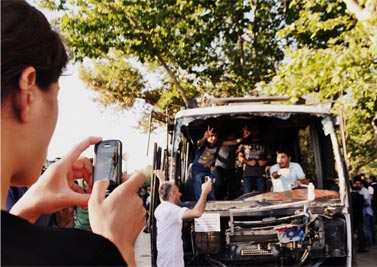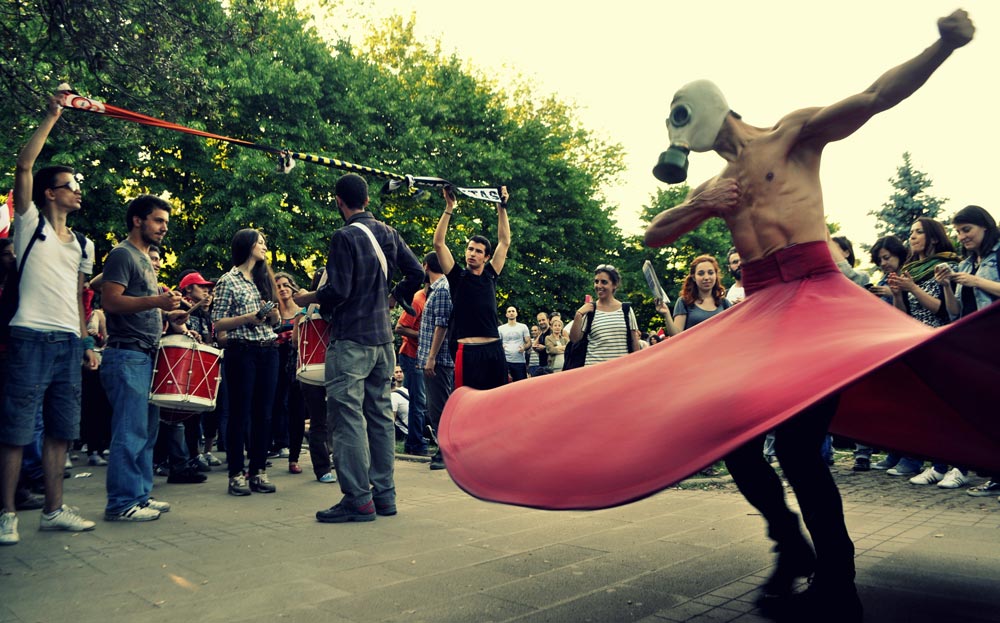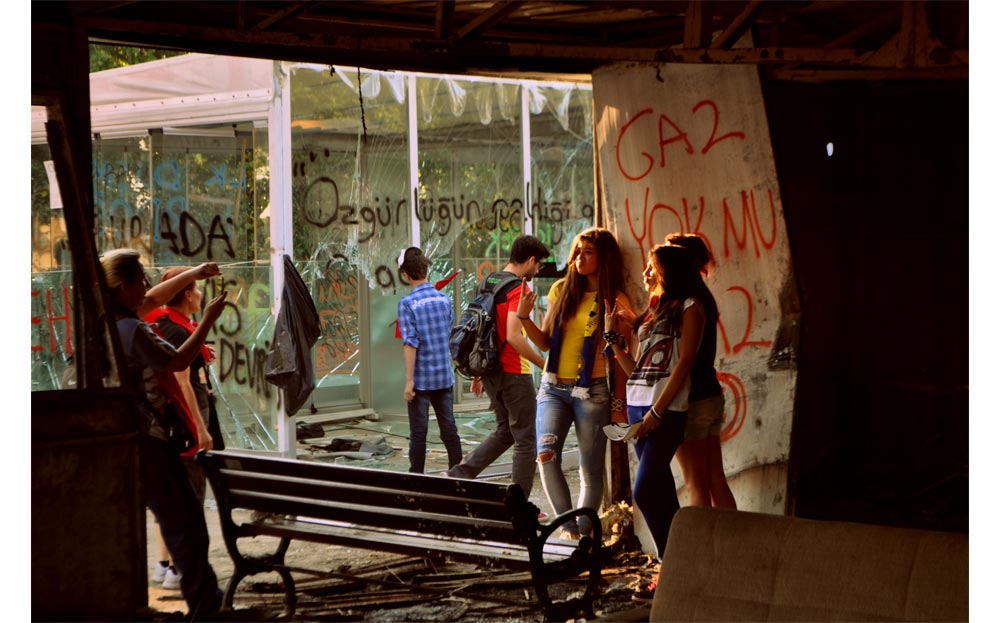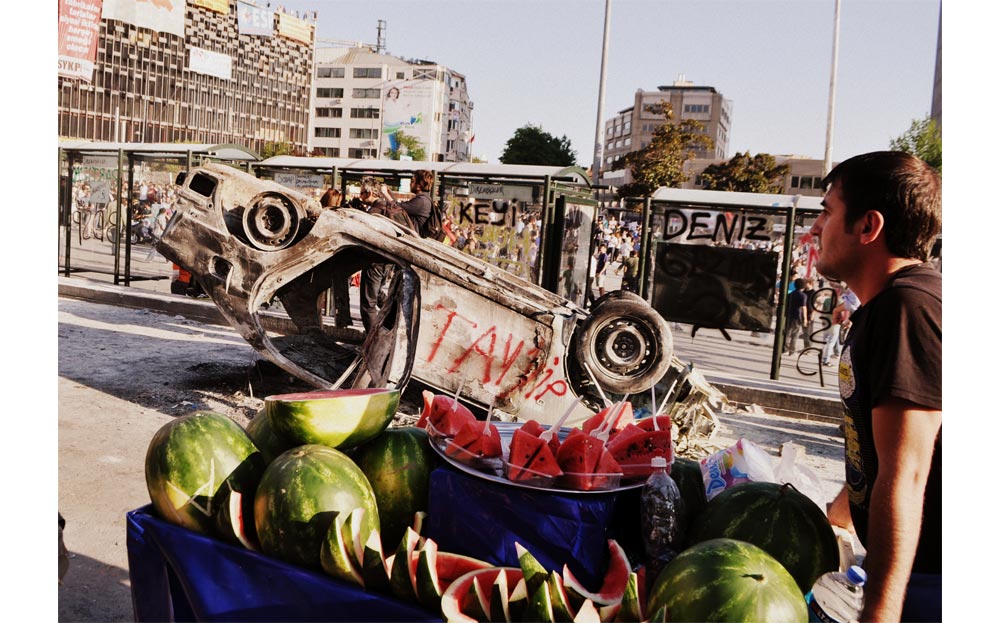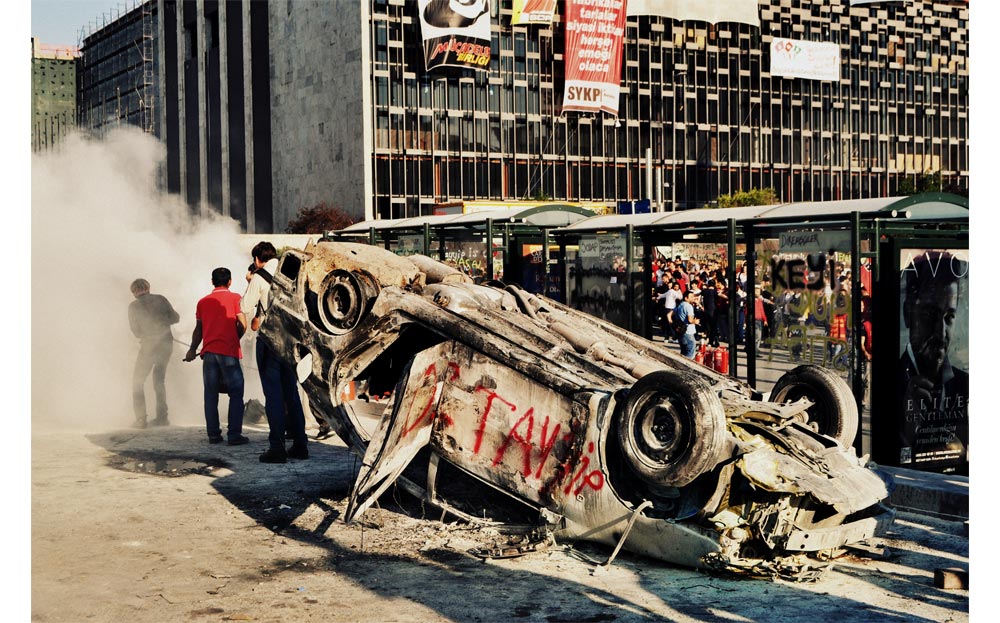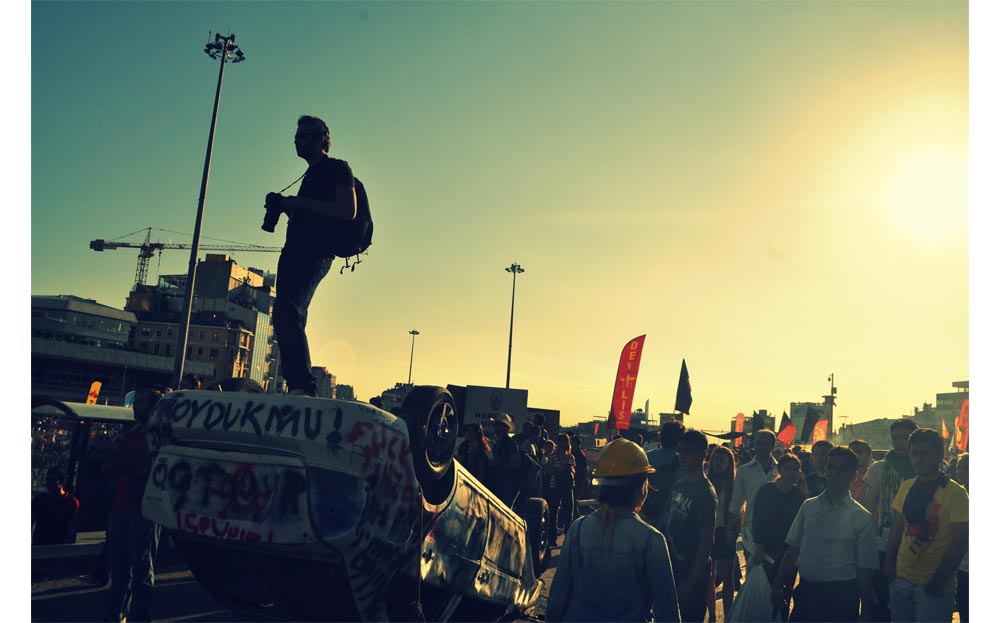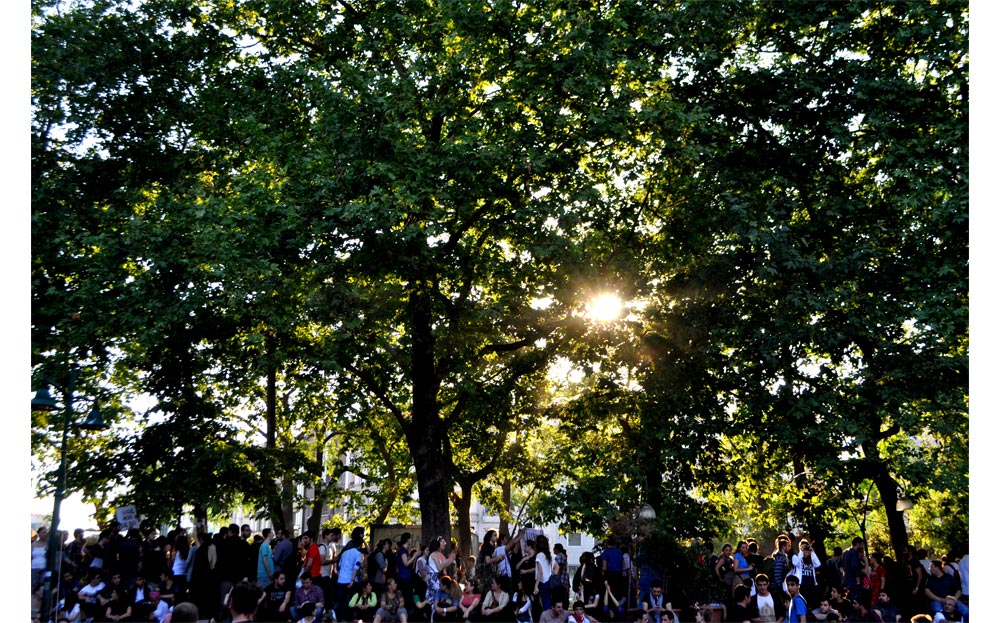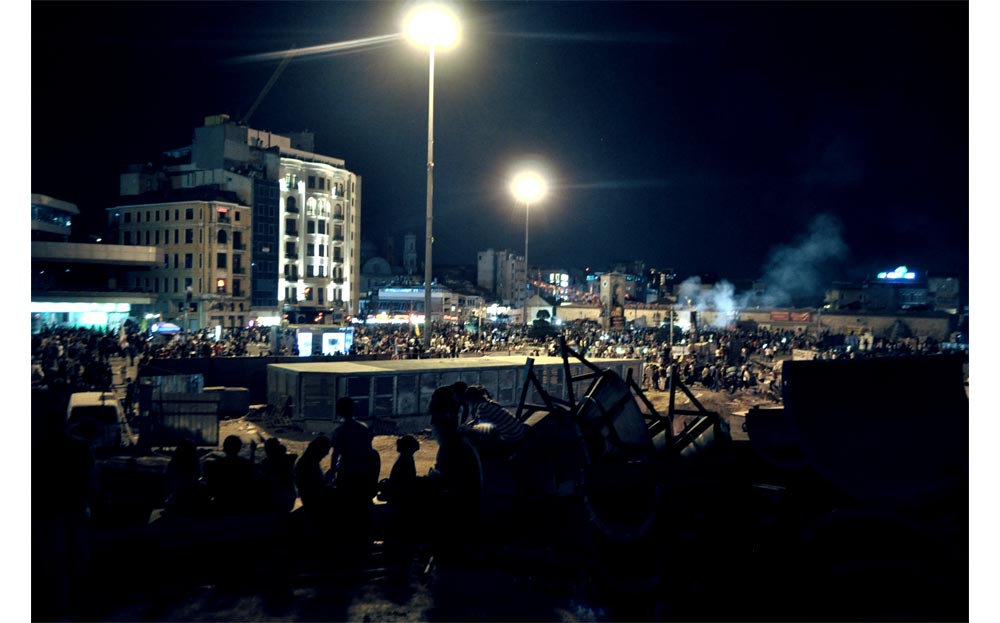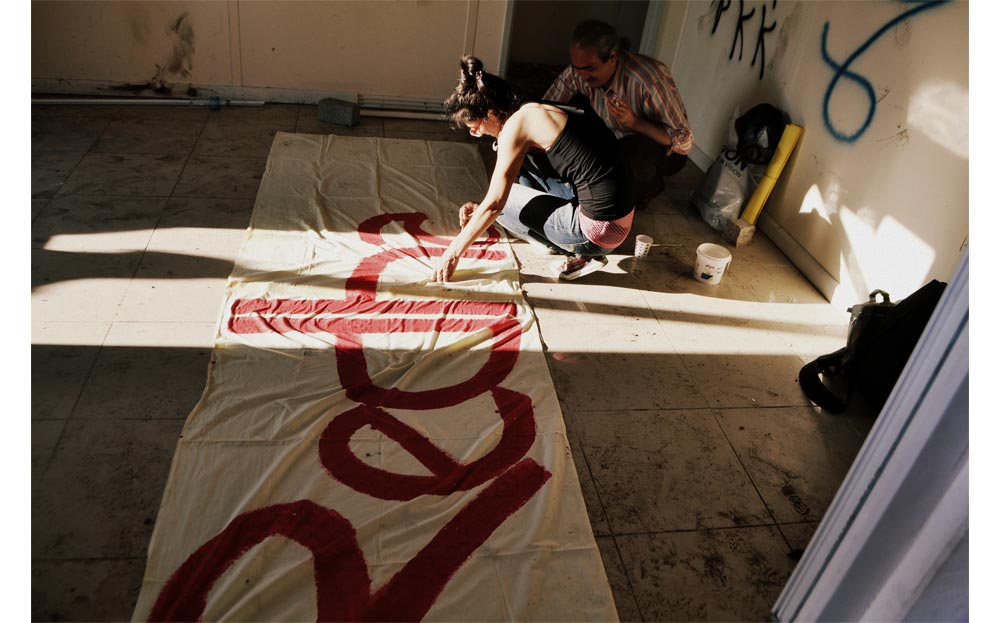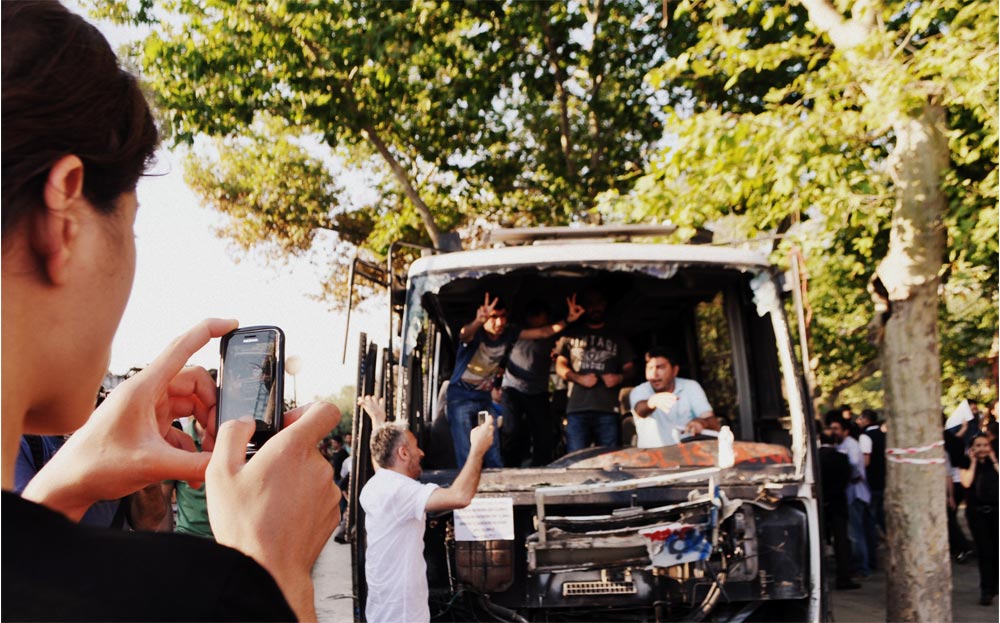By Jennifer MacKenzie
“We were apolitical before,” Melih told me between sips of Efes, Turkey’s national beer. “Our parents were apolitical, and they taught us to be, too.” A lanky twenty-something grad student with a long blond ponytail, he was perched on lumber torn from the traffic diversion project encircling Taksim Square at our feet. The protests that had flared up unexpectedly nine days ago had engulfed its scaffolding and construction vehicles and left them stranded and graffitied on the smooth, newly poured concrete now charred by a series of bonfires. Melih smiled surveying the crowd fluxing across it.
“Now, he declared, “my generation is entering politics.”
It was quite an entry. In Taksim, before the gleaming Marmara Hotel, street vendors were doling out watermelon and pineapple slices, stuffed oysters, and grilled beef patties to the thuds of competing drum circles. From a hand-trolley stacked with blue cans, the guy we had bought our beer from was doing a brisk business among the throng of students and families, many wearing Turkish flags draped over their shoulders like red satin capes. On top of a smashed-up city bus to our left, to the cheers of a milling audience, a dozen or so young men were jumping up and down chanting, “Jump, jump, jump, if you don’t jump, you’re Tayyip”—Recep Tayyip Erdogan, that is, Turkey’s prime minister and the instigator of the construction works in disarray around us.
Protest paraphernalia for sale included Turkish flags, Ataturk flags, Guy Fawkes “Anonymous” masks, Ataturk-style military hats, socks, bug spray, neon goggles and flimsy white gas masks that do not (it turns out) actually filter out tear gas.
“Everyone’s become a frat boy,” Melih’s girlfriend Ilke observed. Indeed, what had started twelve days before as a small sit-in protesting the slated demolition of the park behind us had become a sprawling carnival. Only last weekend, buying or drinking beer on the streets had been unthinkable; besides further raising taxes on alcohol and cigarettes, a recent law passed by the AKP, Erdogan’s Justice and Development Party, had also banned the sale of alcohol between 10 p.m. and 6 a.m.
By the time we sat sipping our beers overlooking Taksim, open-air alcohol sales had been upgraded to include hard liquor, with vendors along Istiklal Avenue hawking shots of Chivas, Absolut Vodka and Johnny Walker. Protest paraphernalia for sale included Turkish flags, Ataturk flags, Guy Fawkes “Anonymous” masks, Ataturk-style military hats, socks, bug spray, neon goggles and flimsy white gas masks that do not (it turns out) actually filter out tear gas.
There hadn’t been a whiff of gas in Taksim for a week, since the previous Saturday afternoon when hundreds of riot police withdrew after firing thousands of rounds of tear gas at dogged protestors. Police continued to use gas and truncheons against protests in other cities. But in Taksim, historically the center of protest against whichever party holds sway, festive commerce reigned. As glowing paper lanterns ascended into the night sky, smoke from grilling beef had replaced tear gas, and the bright pink, green, and yellow goggles for sale served as saucy souvenirs.
Explicit politics were not entirely subsumed, but ideology had taken a backseat to individual displays of liberty, from open-air yoga practice to the twirling of a post-modern whirling dervish, bare-chested and wearing a gas mask. Opposition parties were nevertheless striving to seize the day, their colorful banners bristling from beside a slew of smashed-up buses. Ilke complained that these parties hadn’t been subsumed enough, since provincial TV audiences would see their symbols on the news and blame everything on their parties’ largely discredited agendas. Like the majority of young people waving flags, Ilke and Melih are unaffiliated with any party. Beneath its denunciatory whistle-blowing, their struggle is thus to create a viable alternative to the political status quo.
In Melih’s opinion, the AKP came to power eleven years ago because every other choice seemed worse: the other parties running were seen as hopelessly corrupt. Turkey thus slid into its fragile democratic condition with a shrug. Fragile because since Ataturk took off his Ottoman uniform and declared Turkey a republic, the military remained the final arbiter of state policies, serving in this capacity by effecting a coup every decade or so. But in 2008, Erdogan foiled the latest of such coups, outmaneuvering the army to put it “back in the barracks” and out, finally, of politics. He won that battle through strong support from Turkey’s biggest industrialists and its burgeoning middle class, who preferred the reduced corruption and increased profits his party delivered, along with a military subservient to its political will.
Because the EU’s rejection was perceived as partly political, blocking the entry of 70 million Muslims into a European institution, it also heightened the tensions inherent in Turkish political identity, which remains a mix of secular and religious influences.
Paradoxically, it is his successes rather than failures that have laid the groundwork for Erdogan’s current confrontation. In his decade as prime minister, he revived Turkey’s stagnant economy, largely by privatizing national industries and undertaking numerous huge infrastructure projects, including increased investment in neglected Kurdish areas. In pursuit of EU membership, he also enacted numerous economic reforms. When the EU refused this bid for membership, Turkey shifted its focus eastward towards markets and alliances in Asia, Africa and the Arab World.
Because the EU’s rejection was perceived as partly political, blocking the entry of 70 million Muslims into a European institution, it also heightened the tensions inherent in Turkish political identity, which remains a mix of secular and religious influences. The AKP is Islamist, but has generally shied away from directly announcing this. As the third generation of Islamist political actors in Turkey, Erdogan and his allies have deployed a more subtle mode of shaping the Turkish state than the coup-makers that preceded them. They have attempted to achieve their goals by constitutional means, under the terms of Kemalist values, using soft power to consolidate their position.
Followers of Erdogan’s sometime-ally, the charismatic Islamist Fethullah Gulen, have also established over three hundred schools in Turkey whose curricula and codes of conduct encourage Islamic values. Their standards of excellence have provided thousands of poor students, including Melih and his friend Emirhan, educational opportunities they couldn’t otherwise afford. But Melih, now an avowed aetheist, recalls how even as an agnostic he found himself swayed towards religion by this academic environment, which he and Emirhan believe pushes many students into conforming to its standard of piety. They also allege that graduates from these schools are given hiring preference in government jobs, particularly in police departments.
I was acutely aware of this difference [between Turkey and the Arab Spring countries] as I got soundly gassed on May 31st.
The core of protestors’ grievances is thus that while all ships have risen with the Turkish tide, the AKP’s have risen higher than others’, and that this elevated position has increased its leadership’s arrogance. Erdogan meanwhile is revising Turkish law in his own favor, increasing presidential powers in preparation for assuming that office next year. Because the mainstream media are owned by the same businessmen who support the AKP, Turkish news does not criticize these developments, nor the fact that, as of last year, Turkey had the highest number of imprisoned journalists in the world. But many Turks have been angered by newly imposed restrictions including a near-total ban on abortions and municipal warnings against kissing in public. Internationally, greater Turkish rapprochement in the Muslim world, including support of Islamist Sunni militias in Syria, is also implicitly altering the orientation of the Turkish state, while renewing sectarian tensions in the country and region.
“Occupy Gezi Park,” as the few dozen protestors dubbed their initial May 27th sit-in, aimed to link their struggle to that of western Occupy movements which challenged the political hegemony of an economic elite. In these terms, the envisioned redevelopment slated for Gezi Park—a mall and a replica of Ottoman barracks that once stood on the site—perfectly embodied the marriage of increased piety and purchasing power that the AKP stood for, and protestors denounced it as an underhanded way of imposing a neo-Ottoman face on a central public space. A poster of a turbaned Erdogan which read, “We will not kneel to you, Sultan” carried the overall political orientation of the event, asserting popular political will against the AKP’s revisionist version of Turkish identity.
Once protests mushroomed against the government’s crackdown on this first protest, participants and their demands likewise multiplied into a kaleidoscope of political factions waving a multitude of flags, from anarchists to Muslims against capitalism. Gezi Park became a patchwork of campsites that ranged “the lesbians next to the Kurds next to the Armenians next to the vegans,” explained Elias, a resident Lebanese art critic who followed his milieu into the park, where he slept for three nights.
For Elias, the sudden rift between support for and opposition to the Turkish government that developed over Gezi Park was driven more by economics than religion. “He’s got the top and the bottom wrapped up tight,” Elias commented, referring to Erdogan’s upper- and lower-class supporters. “This is about the middle class elbowing for their rights.”
“They need to see us,” insisted Oz, a 29-year-old protestor from Istanbul. “They haven’t seen us yet. The government made enormous progress in the last ten years, and we were supporting them. But at the same time they were putting their ideology onto the people. So either they need to change their style or they need to go.”
In Taksim, several banners featuring a beatific Ali, the founding figure of the Alawi sect whose members comprise at least 20% of Turkey’s population, denounced this style with the declaration, “We refuse to name the third Bosphorous bridge after Sultan Selim”—the fifteenth century Sultan who enormously expanded the Ottoman empire but also slaughtered thousands of Alawis as apostates.
Fraught as it is, the structure of this impasse is partly imaginary: that is, there is no political consensus as to what a progressive future for Turkey looks like.
As proof of the galvanizing power of AKP’s revivalism, Emirhan showed me a video of a friend being beaten by party supporters in neighboring Tophane. “And they’re not chanting for the AKP,” he exclaimed. “They’re chanting, ‘We are the sons of the Ottomans!'”
In Erdogan’s hometown of Rize, pro-AKP supporters put it even more bluntly as they besieged dozens of Labor party members inside a building, stoning it and chanting, “This is Turkey, there is no way out.”
Fraught as it is, the structure of this impasse is partly imaginary: that is, there is no political consensus as to what a progressive future for Turkey looks like. Kemalists’ secular nationalism and AKP members’ liberal conservatism are both right-wing movements in that both are conservative, looking back with reactionary nostalgia to a Great Dead Leader. For Islamists, this figure is a bearded man in a turban; for Kemalists, he is clean-shaven and wearing a tall fur hat.
I wandered into the Kemalist version of utopia walking home in mid-May, when I found Republic Boulevard, the main street of my central Istanbul neighborhood of Sisli, transformed into an Ataturk theater set. For many blocks, the ten- and twelve-story office buildings lining the boulevard were draped with huge portraits of the republic’s founder, black and white images on red backgrounds that covered nearly the whole of each building’s façade.
And there were so many Ataturks to choose from. Writerly Ataturk in spectacles, gazing into the future he was composing; sternly earnest young Ataturk; old, mellowly magnanimous Ataturk; Marlon Brando Ataturk looking distinctly Godfather in a double-breasted suit and jowls; and a warrior Ataturk on a wheeling horse that could have been done by Goya.
Coming to Turkey after living for four years in Syria, I found such ubiquitous images of a dead leader disquieting, signs of requisite compliance with a dictator’s rule, a monolithic obeisance in portrait décor.
Walking along the clean, empty street was like strolling through a movie house that had been advertising only one film continuously for the last 90 years. In fact, the banners were part of Istanbul’s preparations for Youth Day on May 19th, which Ataturk claimed was his birthday. But they only magnified the way that Ataturk images permeate daily public space throughout Turkey as statues in public squares, photographs in offices and schools, and even squinty bronze masks affixed to buildings.
Coming to Turkey after living for four years in Syria, I found such ubiquitous images of a dead leader disquieting, signs of requisite compliance with a dictator’s rule. The same monolithic obeisance in portrait décor was practiced in the autocratic regimes across the Arab World, where the iron-fisted secularists who rose to power in the wake of national independence movements used the threat of foreign occupation to viciously repress their own people. Ataturk managed to spare Turkey the colonial legacy that befell the former Ottoman provinces further east. But he also eliminated internal challenges to his version of nationalism, arresting, banishing, and in some cases assassinating members of Communist and Islamist factions.
So while Kemalists celebrate Ataturk as the father of Turkish liberty—through the establishment of women’s rights and a new, Turkish alphabet and educational system that caused popular literacy to soar—Islamists recall him as the suppressor who in one fell swoop destroyed a glorious Islamic legacy, rendered the wisest scholars in the land illiterate, and banned fundamental religious practices (including the wearing of headscarves in public universities and offices, and participating in religious parties and associations). In the first frames of a popular Kemalist protest video circulating across Facebook, Ataturk appears as the Godfather of current protests, squinting like a ghostly avenger through the mists of time—which then roll away to reveal the current confrontation as valiant protestors romantically defying brutal, out-of-touch authorities. The adrenaline rush that comes with being tear-gassed can be exhilarating. But the noble flag-waving resistor who figures as the inheritor of the mythical Ataturk’s fight against darkness bears no resemblance to the actual Kemalists who followed in Ataturk’s footsteps and who were decidedly marching in lockstep.
True, three weeks of protests, a staggering 130,000 canisters of tear gas were fired by Turkish police, five protestors and one policeman were killed and according to the Turkish Doctors Association, 43 seriously wounded. But casualties in this latest crackdown are mild compared to the 34 to 42 protestors killed in the Labor Day demonstration in Taksim in 1977, whose deaths represent just a fraction of the political violence that beset Turkey in the ’70s. Historically speaking, forcefully quashing dissent is business as usual in Turkey—which is why, as Melih said, so many Turks preferred to stay out of politics.
Though the media were quick to label events in Taksim the start of a “Turkish Spring,” Turkey is not the Middle East; politically as well as geographically, it is a hybrid, with conditions and expectations far different than those in the Arab world.
But this May, Erdogan reached the limits of their patience when he too dispersed a handful of protestors with a heavy-handed show of force. The instant connectivity afforded by Facebook and Twitter allowed the news of the crackdown to spread simultaneously with its occurrence, and anyone who nursed a grievance against the state suddenly felt attached to this issue and went out onto the street.
This model of spiraling escalation of protests in response to state-sponsored violence is of course the pattern that unfolded in Arab Spring countries, as is the flourishing of grassroots media and citizen journalism opposed to state media structures. But though the media were quick to label events in Taksim the start of a “Turkish Spring,” Turkey is not the Middle East; politically as well as geographically, it is a hybrid, with conditions and expectations far different than those in the Arab world.
I was acutely aware of this difference as I got soundly gassed on May 31st, as I was in the company of a Syrian friend when it happened. Escorting him to the bus station beside Taksim, I blithely led him out of the Taksim Metro exit at 5:45 p.m., whereupon we found ourselves facing a phalanx of riot police; at our backs, several hundred protestors were chanting vigorously against them. My friend is unable to run, since his left shinbone was pulverized a year ago by two Kalishnikov bullets. We were thus walking as quickly as possible towards the police (in my mind, to distance ourselves from the protestors) when they fired a barrage of tear gas.
Ignominiously, I removed my shoes and ran away barefoot and blindly weeping; the police seized my friend by his hair and clubbed him on his back before he too managed to escape. The degree of violence represented by tear gas on a Syrian scale was evident in my friend’s response: when we reached the bus station, where we became hemmed in by waves of tear gas and protestors, he stood outside in the stinging air and smoked.
Though local activists started calling for Taksim to be a Turkish Tahrir Square, the contexts of the two are vastly different. The Tahrir sit-in grew so rapidly in early 2011 partly because youth unemployment in Egypt was outrageously high, and so it remains in mid-2013, as the value of the Egyptian currency continues to drop; the human anxiety pervading the area is how its residents will be able to afford bread.
By contrast, Taksim is the center of a bustling commercial district where the pervading anxiety is whether residents will be allowed to enjoy the civil liberties they have come to expect along with their globalized consumer lifestyles. During working hours in the week of open protests, it was only mildly more crowded than usual, as most Turks hold full-time jobs and complain not about lack of work but the length of their commutes. Most of those who filled the square nightly poured in on the Metro after work and left again on the last train.
Then too, Turkish calls for “the fall” of the Turkish government are incommensurate with the same chants in Arab Spring countries, as Turks elected their government. “Here there’s a democracy,” exclaimed Moustafa, a 26-year-old AKP supporter. “He [Erdogan] was elected three times; how can you say he’s a dictator if fifty percent of the population elected this guy?” Erdogan’s declaration in a recent speech in Ankara that “we take orders from nobody but God” is thus also technically untrue, but the hard line pleases the supporters he wants to galvanize.
So rather than change tacks, Erdogan responded to increased protests by staging a replay of the initial crackdown on Gezi Park, but on a much larger scale. Two weeks and nearly two days after the first tear gas was fired, and four days after removing the barricades surrounding Taksim, riot police again cleared the park with massive outpourings of tear gas and water, beating protestors and burning their tents. Many of those dispersed, including mothers and children, fled into the five-star Divan Hotel adjacent, whereupon police fired tear gas into its lobby.
The mass of displaced protestors then tried to occupy Republic Boulevard leading to Taksim, where they were joined by thousands of others. The street past Sisli filled with a milling chaos of people wearing hard hats and masks who dragged stone planters, garbage and lumber from nearby construction sites into the street to make impromptu barricades. Police surrounding the park and guarding the streets feeding onto the boulevard stymied their advance and repeatedly drove them back; for hours the air was stinging with gas. As it was Saturday night, no one had to work the next day, and people stayed out until the early morning, and came out the next day, advancing and retreating and failing to break into Taksim.
The following evening, Erdogan held the first of a series of massive rallies. Speaking to a larger crowd than he gathered during his last election campaign, his back to the old walls of Constantinople that the Ottomans had so ingeniously breached, he played the populist—flanked by towering images of his own face—in a blue plaid shirt with the sleeves rolled up like someone out of This Old Ottoman House. As his supporters chanted “let the hands that touched the police be broken,” Erdogan reaffirmed that the protestors were agents of a foreign plot and that, if they entered Gezi Park, they would be treated as terrorists. Doctors who had treated the wounded and lawyers who defended the detained were meanwhile detained from their offices.
By playing his response hard, Erdogan is gambling on benefiting from the protests by increasing tensions between his opponents and supporters. In a consummate piece of urban political theater, he orchestrated the use of public space of Istanbul so that simultaneously, the central space of civic, civil dissent—Taksim Square and Gezi Park—was blasted empty, cordoned off by riot police and the closure of three Metro stations, while the space of Ottoman triumph was filled with tens of thousands of his cheering supporters. The juxtaposition is deliberately telling. In democratic terms, Erdogan holds power through the consent of fifty percent of Turkish voters. But according to the script of the play he’s stage-managing across Istanbul, his grasp on the body politic is a roaring one hundred percent “yes.”
On Sunday just hours after Erdogan’s speech had finished, I walked through central Istanbul at dusk, crossing the gray area of divided popular opinion, trying to absorb its mixed and fraying signals. After scraping over the remains of a barricade of bricks, my taxi was forced to halt at the southern edge of Sisli, behind a traffic jam caused by a knot of chanting protestors. I crossed into poorer Kurtulus on foot, skirting a series of small clashes between protestors and police down narrow side streets.
If he were a policeman, he declared, he would walk on their heads.
Inside Kurtulus, the tang of tear gas in the air abated, and the clanging of pots and pans—the nightly 9 p.m. protest from balconies and rooftops—tapered off. One cluster of half a dozen people doggedly clanged from a doorway, but the other pedestrians walked on without comment. Nearing my friend’s house, I found myself behind a family returning home from Erdogan’s rally carrying AKP flags, the women wearing headscarves. The neighborhood is full of immigrants: Nigerians, Iraqis, Afghanis, and Syrians. When I reached my friend Bilal’s house, my friend, himself Syrian, roundly cursed the protestors and opposition parties whom he said wanted “to destroy the world.”
That week, his sister had lost her new job at a tourist agency near Taksim when it closed from lack of business. Bilal, who works illegally for a pittance at a hotel near Taksim, had spent all day ferrying the few tourists who dared the journey through police lines and tear gas until his lungs burned. Between trips, he watched from the hotel balcony as protestors tore bricks and stones from the streets to make barricades, while others threw glasses from their rooftops onto the police. If he were a policeman, he declared, he would walk on their heads.
A downstairs neighbor, also Syrian, had just returned from Erdogan’s rally and reported jovially that it was huge, with many of the city’s Syrian residents in attendance.
“But isn’t Erdogan doing to Turks what Bashar did to Syrians?” I asked, knowing that all present were ardently anti-Assad.
Freedom of expression is permissible, as long as it is enacted silently by a troupe of mimes.
“Let me tell you the difference,” the neighbor said firmly. “In Syria, Bashar stole from the people for the last ten years and made everyone poorer. Here, Erdogan made everybody richer. They have cars now, and designer clothes, and jobs.” Clinging to the bare edges of this prosperity, he—along with many Turks—prefers secure repression to an uncertain alternative.
“That’s so Arab,” Elias, the Lebanese critic, hissed the following week as we walked through Taksim. “To love a tyrant because he feeds you.” We strode quickly past few dozen “standing man” protestors, motionless at attention facing the Ataturk cultural memorial now stripped of all opposition banners. They are all that’s left of the hundreds of discussions that filled the same space just days earlier. In the ongoing contest between protestors and authorities, the scope for licit dissent has been whittled down to just this: a collective, wordless standstill.
The piano player who was detained for leading a chorus of “Do You Hear The People Sing?” in the middle of Taksim has been released, along with his piano. But the wave of arrests has made its point: articulate objection in virtual or physical space is taboo. Open forums to discuss opposition tactics have continued in parks across the country since Gezi Park was cordoned off, but the position enacted by the authorities demonstrates that freedom of expression is permissible, as long as it is enacted silently by a troupe of mimes.
The silence is a great loss to Turkey, not least because the conversations that opened up here revealed that Turkey’s diverse oppositionists have just begun to understand one another’s views, let alone those of the other fifty percent.
“I thought I was open-minded and didn’t have any prejudices, but it showed me I was wrong,” Emirhan said about discovering that his pious neighbors had joined the protests. “My neighbors who are religious and conservative also oppose the AKP, and I misjudged them. It showed me that I have to be more open-minded.”
In another circle of grad students, an engineer commented that he felt there was an invisible divide between the conservative and the liberal students. “We don’t talk to each other in class. We make a wall between us. I don’t hear them, and I have no idea if they hear us.”
If there is a weakness to the protests, besides the difficulty of marshalling its myriad factions under one positive claim, it is this lack of rapprochement between the two halves of the Turkish electorate. What Erdogan’s fiery us-against-them direction is creating now is the opposite. In the absence of this mutual “hearing,” as the engineer put it, there is a hardening of self-congratulation that borders on self-righteousness.
In the week of protests before Gezi Park was cleared for the second time, passengers entering and exiting the Metro at Taksim developed the practice of applauding one another as they switched places, like the changing of the dissident guard. One night, when the last train pulled into the station, the arriving cars were completely empty. The doors slid open, and after a moment’s pause, the departing protestors broke into a round of applause. For themselves.
Certainly, when an inflexible authority moves to shut dissent down, up, and out, any noise—even self-congratulation—is a kind of blow against this coercion. But if democracy, as literally “the force of the people,” is to continue to grow in Turkey, it must develop—evidently through struggle—a shared recognition of the claims of all the people. In lieu of this civic opening, citizens will be reduced to the constrained euphemism of their national beer company when on June 13th it closed its website to comply with a new law banning any advertisement of alcohol in Turkey. Below the announcement of the closure, Efes declared with oblique defiance: “But we, we recognize ourselves without seeing ourselves, we know even without seeing…”
Unfortunately, clairvoyance, like pantomime, is not a functional corner from which people-power operates best. For that, as Turks are now asserting, unblinkered vision and open, sustainable discussion are necessities.
Jennifer MacKenzie is a poet and teacher currently living in Istanbul. Her first book of poems, Distant City, will be published in 2014 as part of Fence Books’ Modern Poets Series. Her work has appeared in Killing the Buddha, The Kenyon Review online, and the Near East Quarterly.
